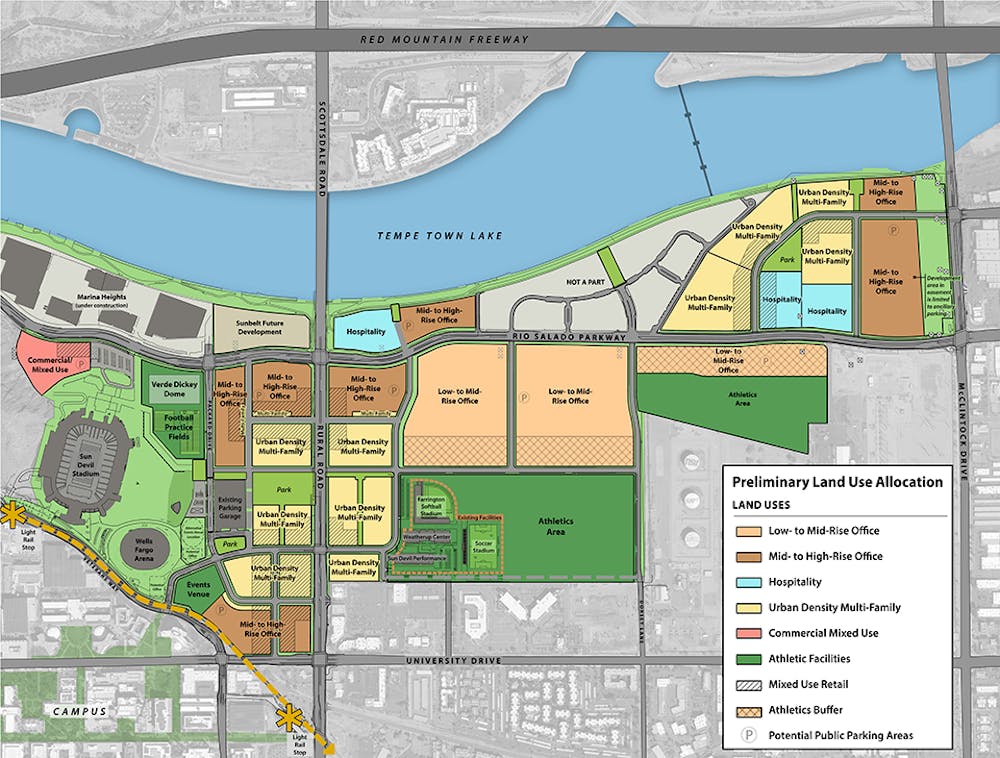Despite recent trends of rapid expansion across the Valley, ASU is slated to grow inward with the forthcoming development of its athletic facilities district.
The district will occupy a 330-acre property owned by the University. It will be bordered by University Drive, McClintock Road, Veterans Way, Tempe Town Lake and Sun Devil Stadium, the in-progress renovation of which is included in the first phase of the development.
Despite its name, not all of the district will comprise athletic facilities; much will be leasable to private developers and business, providing income to the University to fund big-ticket renovations like that to Sun Devil Stadium without requiring a tax increase.
"When completed, the district will be a true public/private, mixed-use development," wrote ASU CFO Morgan Olsen in an email. "It will have world-class athletic and recreational venues to support ASU’s mission, public parks and walking promenades to encourage public access, and private sector multi-family housing, class A office, retail and hotel developments."
The Building Owners and Managers Association defines Class A office space as prestigious buildings with above-average rent and a well-defined market presence.
Olsen wrote that he expects to see construction on private office and residential space to begin within 12 to 18 months.
"The goal for the district is to provide a long-term, predictable funding stream for athletic and student venues while enhancing the local economy with projects and tenant activities that will attract jobs to downtown Tempe, all while enhancing the Downtown Tempe/ASU Tempe Campus area for working, studying and living," Olsen wrote.
Much of the land contained within the district is either unoccupied or parking space; Olsen wrote that facilities within the development area will be replaced or moved as part of the buildout plan.
The development will likely be completed within 20 years, according to ASU's website.
The project's master developer is Catellus Development Corporation, which specializes in large-scale, mixed-use developments often formed through public-private partnerships, as is the case with the new district.
Representatives from Catellus were not available for comment within the timeline of this story.
The development was made possible by a piece of state legislature approved in 2010 that allowed for the board of supervisors in certain counties to create a University athletic facilities district on University-owned land.
"It was important for the university to select a developer with experience in complex, long-term public sector land developments, the capital required to develop the entire district and a reputation that will attract world-class developers and users," Olsen wrote. "Catellus uniquely brings all three. For the past 32 years, they have successfully developed similar projects throughout the country."
Catellus will fund the project's infrastructure, while private developers will fund commercial space.
The city of Tempe itself has little jurisdiction in this development, though it will undoubtedly affect the city's central area.
"ASU is the main economic driver of this city," said Tempe city councilwoman Lauren Kuby. "The development will help cement the relationship between the University and the city."
Although the University has essentially free reign in this project, Kuby said it is possible that the city may help the development through incentives like tax abatement in certain areas.
Kuby said that ASU's reputation for innovation make the University a brilliant collaborator for the city, though she is aware that a project of this scale will cause headaches — things like increased traffic, congestion and reduced parking space.
That said, she is excited about the district's commitment to sustainability boosting the city's environmental reputation.
Details for how the district will encourage sustainability are not yet available, though according to the University's website, it will offer green design and infrastructure and reduce dependance on automobiles through public transport and bicycle accessibility.
This type of development is necessary as the city has nowhere to go but inward, said Tempe councilman Kolby Granville.
"Tempe is a landlocked city, so the only development we're ever going to get is infill," he said. "We have a clear vision of where development would go and where it wouldn't. Density makes more money for (ASU)."
Like Kuby, Granville is concerned about the effects the development will have on traffic.
"Rural will become a 25 or 35 mile-per-hour street," he said.
He said he might prefer developments that are more directly beneficial to ASU students and the Tempe community at large, but that the University has control over this development and likely knows what is best to help its growth.
Reach the reporter at Arren.Kimbel-Sannit@asu.edu or follow @akimbelsannit on Twitter.
Like The State Press on Facebook and follow @statepress on Twitter.




